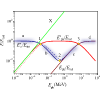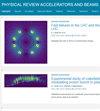From Compton scattering of photons on targets to inverse Compton scattering of electron and photon beams
IF 1.8
3区 物理与天体物理
Q3 PHYSICS, NUCLEAR
Physical Review Accelerators and Beams
Pub Date : 2024-08-28
DOI:10.1103/physrevaccelbeams.27.080701
引用次数: 0
Abstract
We revisit the kinematics of Compton scattering (electron-photon interactions producing electrons and photons in the exit channel) covering the full range of energy/momenta distribution between the two colliding particles, with a dedicated view to statistical properties of secondary beams that are generated in beam-beam collisions. Starting from the Thomson inverse scattering, where electrons do not recoil and photons are backscattered to higher energies by a Lorentz boost effect (factor ), we analyze three transition points, separating four regions. These are in sequence, given by increasing the electron recoil (numbers are for transition points and letters for regions): (a) Thomson backscattering, (1) equal sharing of total energy in the exit channel between electron and photon, (b) deep recoil regime where the bandwidth/energy spread of the two interacting beams are exchanged in the exit channel, (2) electron is stopped, i.e., taken down at rest in the laboratory system by colliding with an incident photon of energy, (c) electron backscattering region, where incident electron is backscattered by the incident photon, and (3) symmetric scattering, when the incident particles carry equal and opposite momenta, so that in the exit channel they are backscattered with same energy/momenta, and (d) Compton scattering [ála Arthur Compton, see A. J. Compton, A quantum theory of the scattering of X-rays by light elements, Phys. Rev. 21, 83 (1923)], where photons carry an energy much larger than the colliding electron energy. For each region and/or transition point, we discuss the potential effects of interest in diverse areas, like generating monochromatic gamma-ray beams in deep recoil regions with spectral purification, or possible mechanisms of generation and propagation of very high energy photons in the cosmological domain.

从光子对目标的康普顿散射到电子束和光子束的反康普顿散射
我们重温了康普顿散射(电子-光子相互作用,在出口通道产生电子和光子)的运动学,涵盖了两个碰撞粒子之间能量/动量分布的全部范围,并专门研究了束-束碰撞中产生的次级束的统计特性。在汤姆逊反向散射中,电子不会反冲,而光子会在洛伦兹提升效应(因子 4γ2)的作用下反向散射到更高的能量。这些过渡点依次通过增加电子反冲给出(数字代表过渡点,字母代表区域):(a) 汤姆逊反向散射,(1) 电子和光子在出口通道中平等分享总能量,(b) 深度反冲机制,两个相互作用光束的带宽/能量扩散在出口通道中交换,(2) 电子停止,即、(c) 电子反向散射区,入射电子被入射光子反向散射;(3) 对称散射,入射粒子携带相等且相反的矩,因此在出口通道中,它们以相同的能量/矩反向散射;(d) 康普顿散射 [阿瑟-康普顿,见 A. J. 康普顿,《量子散射》[A. J. Compton, A quantitative scattering]]。J. Compton,A quantum theory of the scattering of X-rays by light elements,Phys. Rev. 21, 83 (1923)],其中光子携带的能量远大于碰撞电子的能量。针对每个区域和/或转变点,我们讨论了不同领域的潜在影响,如在深反冲区产生具有光谱净化功能的单色伽马射线束,或在宇宙学领域产生和传播极高能量光子的可能机制。
本文章由计算机程序翻译,如有差异,请以英文原文为准。
求助全文
约1分钟内获得全文
求助全文
来源期刊

Physical Review Accelerators and Beams
Physics and Astronomy-Surfaces and Interfaces
CiteScore
3.90
自引率
23.50%
发文量
158
审稿时长
23 weeks
期刊介绍:
Physical Review Special Topics - Accelerators and Beams (PRST-AB) is a peer-reviewed, purely electronic journal, distributed without charge to readers and funded by sponsors from national and international laboratories and other partners. The articles are published by the American Physical Society under the terms of the Creative Commons Attribution 3.0 License.
It covers the full range of accelerator science and technology; subsystem and component technologies; beam dynamics; accelerator applications; and design, operation, and improvement of accelerators used in science and industry. This includes accelerators for high-energy and nuclear physics, synchrotron-radiation production, spallation neutron sources, medical therapy, and intense-beam applications.
 求助内容:
求助内容: 应助结果提醒方式:
应助结果提醒方式:


